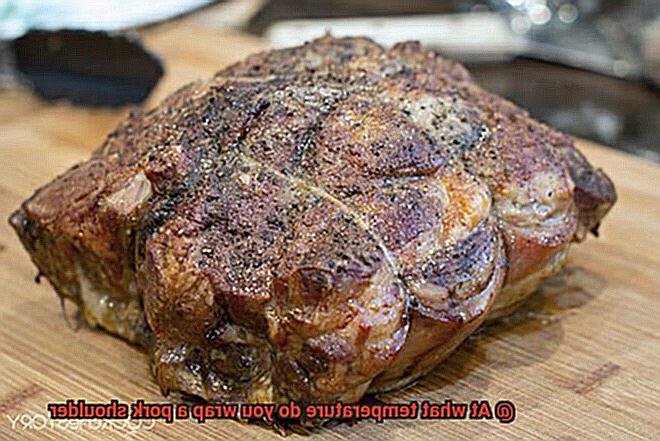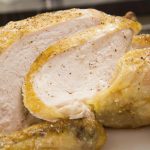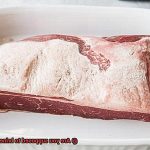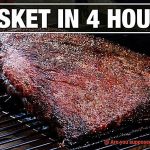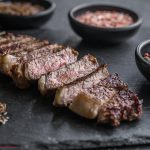Imagine this: The sun is shining, the birds are chirping, and the smell of barbecue fills the air. You’ve got a beautiful pork shoulder on the grill, but as it cooks, you start to worry about overcooking or drying it out. That’s when you remember hearing about wrapping it in foil or butcher paper. But when is the right time to do so and at what temperature?
It’s a question that has stumped even the most experienced pitmasters. Wrap too early and you risk ending up with tough, chewy meat. Wait too long and your pork might end up dry as a bone. And let’s not forget about food safety concerns – nobody wants to serve undercooked pork at their summer party.
So, what’s the solution? In this blog post, we’ll answer the age-old question of at what temperature do you wrap a pork shoulder. We’ll also share some insider tips on how to cook a mouth-watering pork shoulder every time. From different wrapping options to cooking techniques, we’ve got you covered.
Whether you’re new to barbecuing or an old pro, our goal is to help you achieve perfectly cooked pork every single time. So grab a cold drink and let’s dive into the world of pork shoulders.
Contents
When Should You Wrap a Pork Shoulder?
When it comes to smoking a pork shoulder, wrapping it in foil or butcher paper can be a game-changer. This technique can help the meat retain its moisture and flavor, resulting in a tender, juicy, and delicious end product. But the question remains: when should you wrap a pork shoulder?
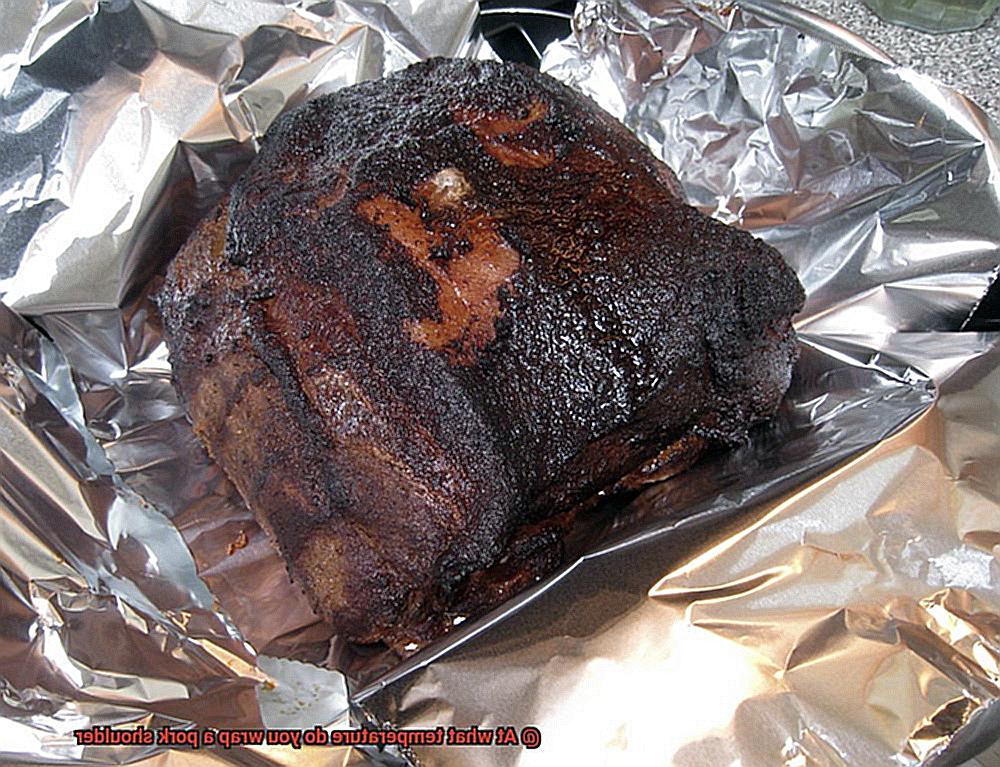
The answer to this question is not as straightforward as you may think. The timing of wrapping your pork shoulder depends on various factors, including the size of the cut, cooking temperature, and personal preference. However, there are some general guidelines that you can follow to achieve the best results.
First things first: not all cuts of pork require wrapping. Smaller cuts like pork loin or tenderloin may not need the extra moisture retention that wrapping provides. However, for larger cuts like a pork shoulder or butt, wrapping can help prevent the meat from drying out and becoming tough.
So, when should you wrap your pork shoulder? The general rule of thumb is to wrap it once it reaches an internal temperature of around 160-170°F. At this point, the meat has already absorbed a good amount of smoke and has developed a nice bark on the outside.
Wrapping the pork shoulder in foil or butcher paper will help trap in some of the moisture and continue cooking the meat until it reaches its desired tenderness. This is especially useful when you hit the stall, which is when the internal temperature plateaus and stops rising for several hours.
However, some pitmasters prefer to wait until the meat reaches a slightly higher internal temperature before wrapping, which can range anywhere from 170-180°F. This can create a firmer, barkier exterior and a longer cooking time overall.
It’s also essential to consider your cooking temperature. If you’re using a smoker that can reach temperatures of 300°F or higher, you may want to wrap the meat earlier to prevent it from cooking too quickly and becoming dry.
Ultimately, the decision of when to wrap your pork shoulder comes down to personal preference and experimentation. Here are some sub-topics you may want to consider:
- Pros and cons of wrapping vs. unwrapped pork shoulder
- Different types of wrapping materials (foil vs. butcher paper)
- How long to leave the pork shoulder wrapped for
- How to tell when the pork shoulder is done cooking
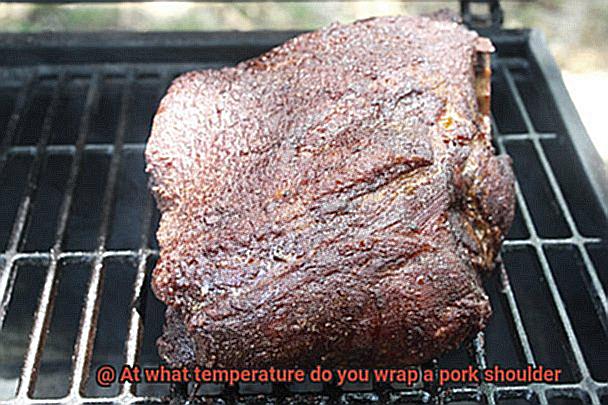
Factors to Consider When Wrapping a Pork Shoulder
The key to a juicy and flavorful end result is all in how you wrap it. But before you start wrapping, there are several factors to consider. As an expert, let me guide you through the most important factors to keep in mind when wrapping a pork shoulder.
First and foremost, consider the cooking method you’re using. If you’re smoking the pork shoulder, it’s best to wrap it once it reaches an internal temperature of around 160-170°F. This typically takes 6-8 hours of smoking to achieve. Wrapping at this point helps retain moisture and tenderness, keeping the meat from drying out.
However, if you’re looking for a crispy bark on your pork shoulder, you may want to wait longer before wrapping. This allows the exterior to develop a flavorful crust before being wrapped to retain moisture and tenderness.
Your desired end result is another crucial factor to consider. Do you want fall-off-the-bone tender meat or a firmer exterior that requires longer cooking time? If you prefer the former, then wrapping at 160-170°F is ideal. But if you want a firmer exterior, waiting until 170-180°F is recommended.
Timing is also essential when wrapping a pork shoulder. Wrapping too early can result in steaming instead of smoking, leading to a less flavorful end product. It’s best to wait until the exterior has had time to develop before wrapping.
Benefits of Wrapping a Pork Shoulder
Wrapping your pork shoulder in foil or butcher paper offers a variety of benefits that will leave your taste buds singing.
First and foremost, wrapping helps to retain moisture and flavor. No one wants to bite into a dry, flavorless piece of meat. Wrapping creates a barrier that traps in all those delicious juices, resulting in a dish that is succulent and bursting with flavor.
But the benefits don’t stop there. Wrapping also speeds up the cooking process by creating a mini oven inside the foil or paper. This ensures that your pork shoulder cooks evenly and quickly, making it perfect for those busy weeknights or entertaining guests.
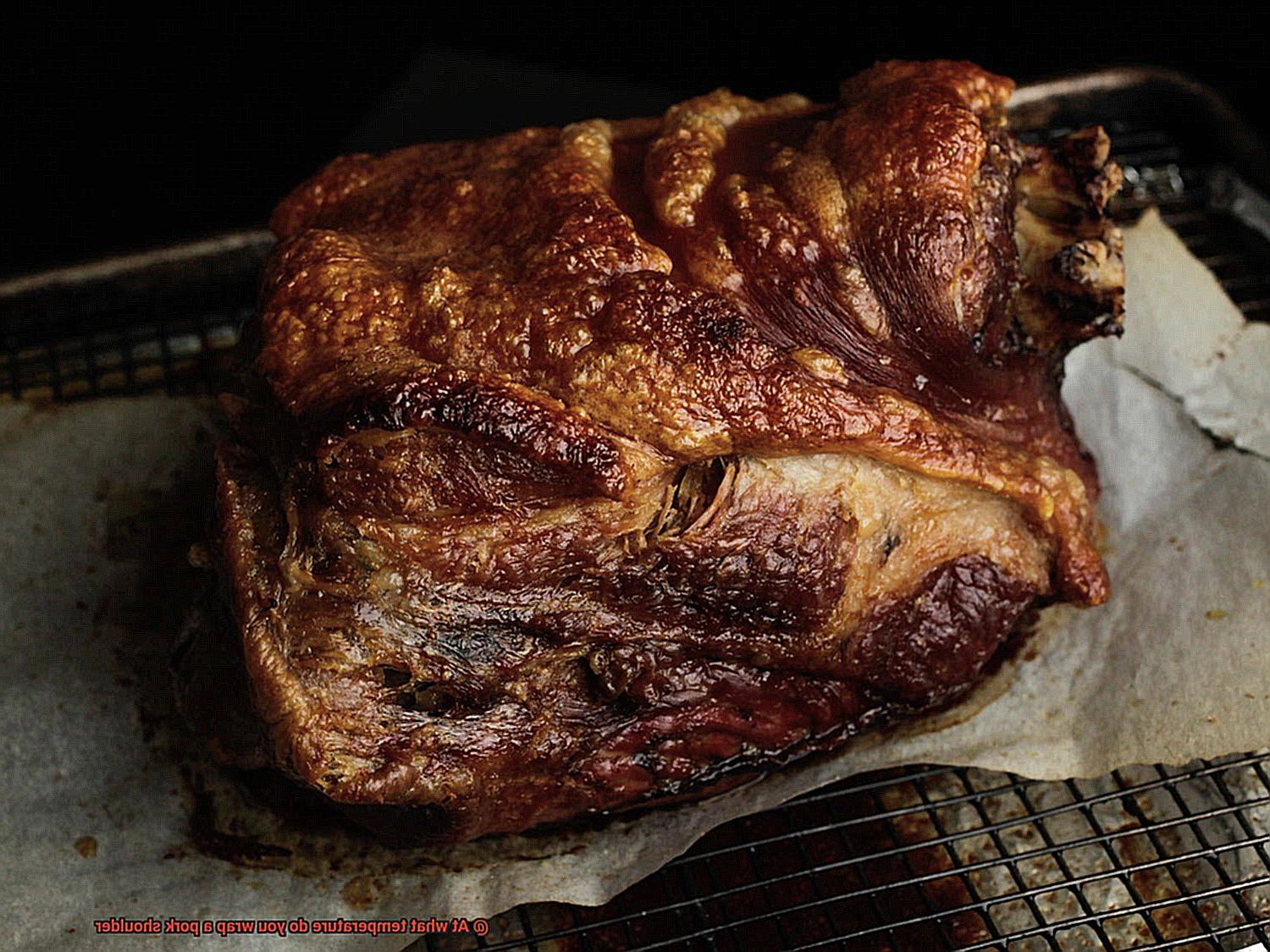
Another major benefit of wrapping is how it helps to create a more tender and juicy end result. The moisture that is trapped inside the wrapping helps to break down connective tissues in the meat, giving you a final product that is melt-in-your-mouth delicious.
And let’s not forget about the importance of letting your meat rest after cooking. Wrapping your pork shoulder in foil or paper will keep it warm and moist while it rests, ensuring that it stays juicy and flavorful.
The General Rule of Thumb for Wrapping a Pork Shoulder
Fear not, because the secret to a perfectly tender and juicy end product lies in wrapping your pork shoulder. But when should you wrap it? As an expert in all things pork shoulder, let me share with you the general rule of thumb for wrapping a pork shoulder.
The magic number is around 160-165°F. Once your pork shoulder reaches this temperature, it’s time to wrap it up. Wrapping your pork shoulder at this point helps to lock in moisture, speed up the cooking process, and create a mini oven inside the foil or paper. This moist environment also breaks down connective tissue, resulting in a melt-in-your-mouth texture and incredible flavor.
But wait, there’s more. The decision on when to wrap your pork shoulder can vary depending on personal preference and cooking methods. Some pitmasters prefer to wrap their pork shoulder at a slightly higher or lower temperature, while others may choose not to wrap at all. It all boils down to factors such as desired tenderness, cooking method, and personal preference.
If you’re new to cooking pork shoulders, following the general rule of thumb of wrapping at around 160-165°F can serve as a helpful starting point. However, don’t be afraid to experiment and find what works best for you. Here are some additional tips for wrapping your pork shoulder:
- Use heavy-duty foil or butcher paper to ensure that the juices don’t leak out.
- Make sure the wrap is tight but not too tight; you want to trap steam inside, but not squeeze the meat.
- If using foil, add a layer of parchment paper between the meat and foil to prevent any acidic ingredients from reacting with the foil.
Different Cooking Temperatures and Their Effect on Wrapping a Pork Shoulder
Then let’s dive into the fascinating world of different cooking temperatures and their effect on wrapping a pork shoulder. As an expert in this field, I’m here to guide you through the sub-topics and share some valuable tips that will make your pork shoulder melt-in-your-mouth delicious.
First off, let’s talk about the ideal temperature for wrapping a pork shoulder. Most pitmasters agree that once the internal temperature reaches 160-170 degrees Fahrenheit, it’s time to wrap. This creates a moist environment that breaks down connective tissue, resulting in a succulent texture that’ll have your taste buds singing.
But here’s where things get exciting. There are different methods and temperatures that can be used to achieve the perfect result. Let’s explore these sub-topics further:
- Low and Slow: Some pitmasters prefer to cook their pork shoulder at a lower temperature, around 225-250 degrees Fahrenheit, for several hours before wrapping. This method allows the meat to develop a rich, smoky flavor and a bark-like crust on the outside. However, patience is key with this method, as it can take up to 12 hours to cook a large pork shoulder.
- Hot and Fast: Others prefer to cook their pork shoulder at a higher temperature, around 300-325 degrees Fahrenheit, for a shorter amount of time before wrapping. This technique can produce a more tender and juicy final product but may sacrifice some of the smoky flavor and bark. If you’re short on time or prefer a more tender texture, then this method might be for you.
- Personal Preferences: Ultimately, the temperature at which you wrap your pork shoulder will depend on your personal preferences and equipment. Experiment with different temperatures and methods until you find what works best for you. Remember always to monitor the internal temperature of the meat with a reliable thermometer and adjust the cooking temperature as needed to achieve the desired level of doneness.
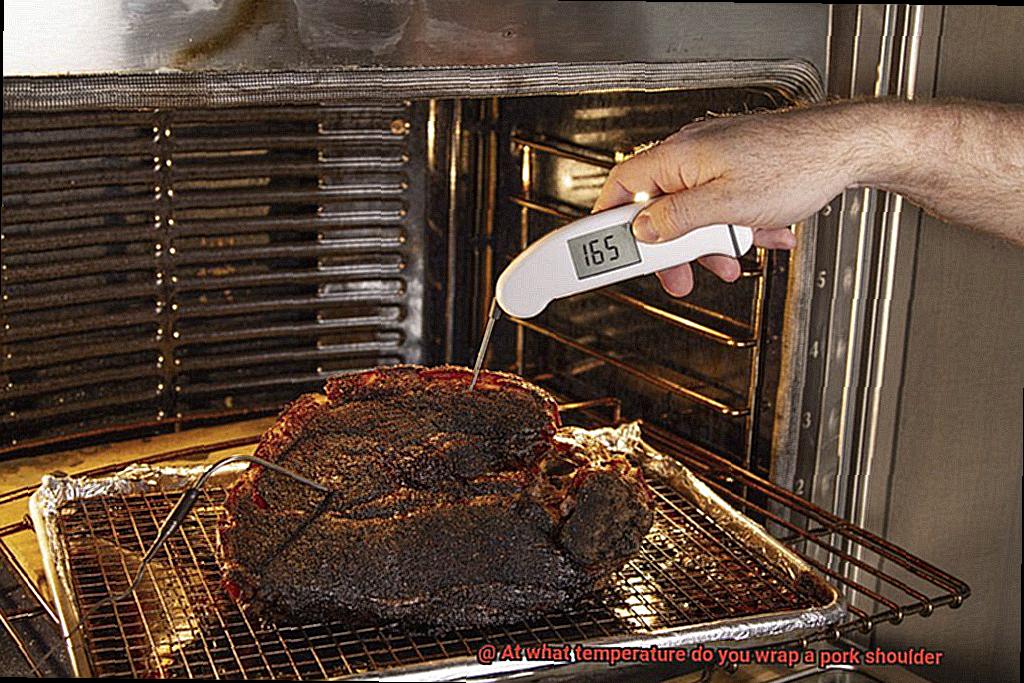
How to Properly Wrap a Pork Shoulder
Smoking a pork shoulder requires patience, skill, and the right technique. One of the most important steps in achieving tender and juicy meat is wrapping it at the right time and temperature. In this blog post, we’ll cover five subtopics that will help you properly wrap a pork shoulder for optimal results.
The Benefits of Wrapping
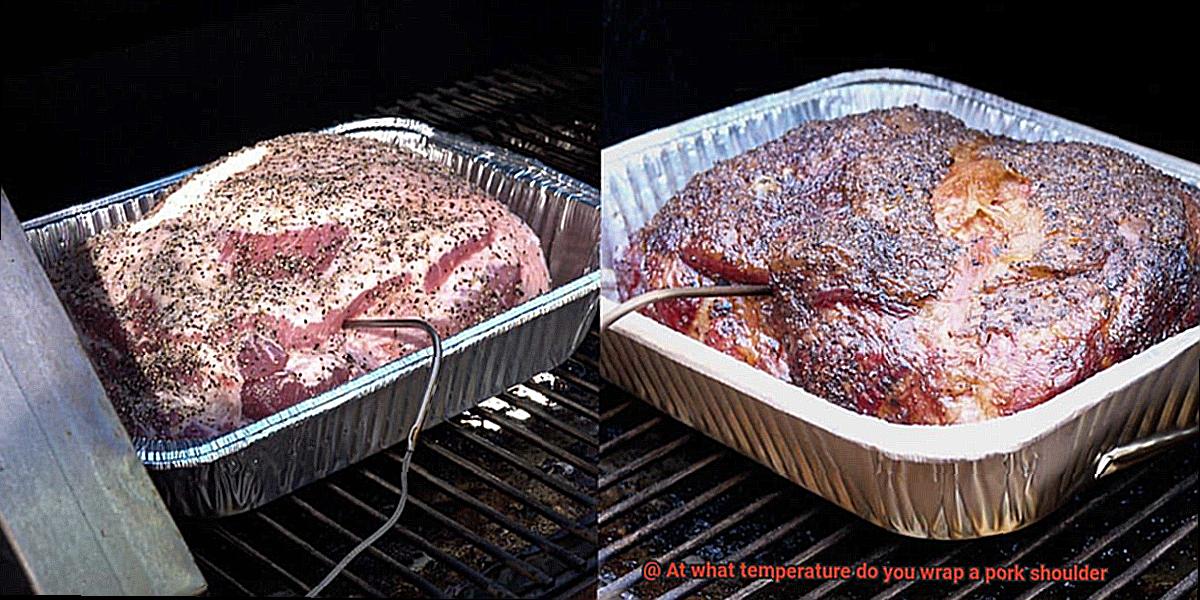
Wrapping a pork shoulder helps to lock in moisture, speed up the cooking process, and prevent the meat from drying out. When the meat reaches around 160-170°F, it enters a stall phase where it stops cooking for an extended period. Wrapping the meat in aluminum foil or butcher paper helps to break through the stall and continue cooking until it reaches its desired tenderness.
Timing is Everything
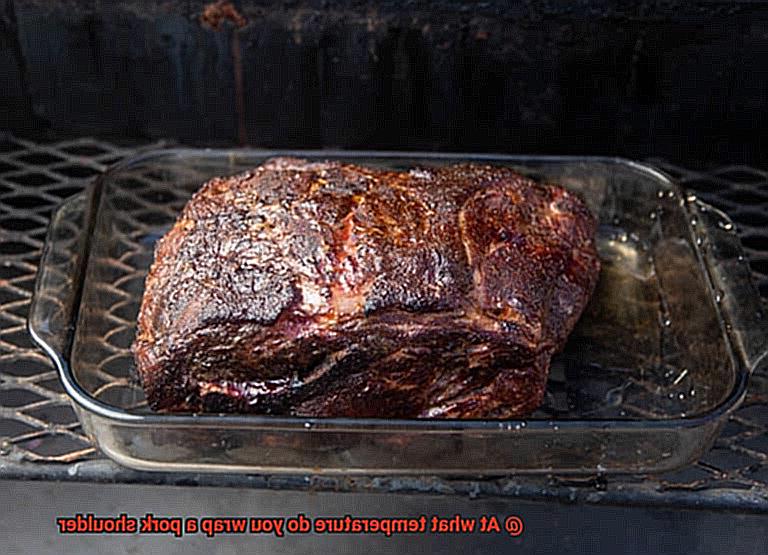
Timing is crucial when it comes to wrapping a pork shoulder. Wrapping too early can result in steaming the meat and creating a soggy texture, while wrapping too late can cause the meat to dry out. The ideal time to wrap is when the pork shoulder has reached an internal temperature of around 160-170°F. This will still allow the meat to develop a good bark or crust while keeping it moist and tender.
How to Wrap
When wrapping a pork shoulder, make sure to use enough foil or butcher paper to fully enclose the meat without any gaps or holes. Creating a tight seal will trap steam and moisture inside, resulting in a more flavorful final product. Once wrapped, return the pork shoulder to the grill or smoker and continue cooking until it reaches an internal temperature of 195°F to 205°F.
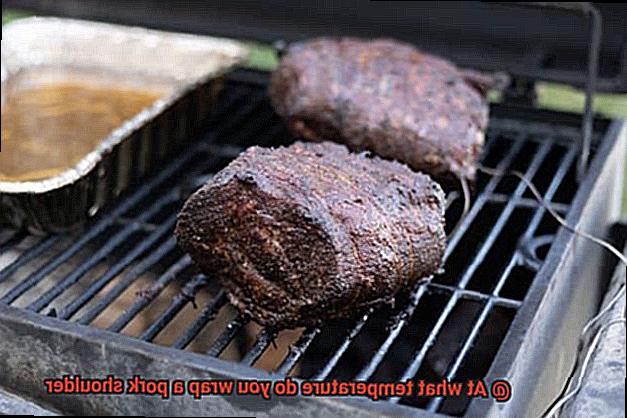
To Wrap or Not to Wrap?
While wrapping is a common technique used by pitmasters, some prefer to let their pork shoulder cook uncovered for the entire duration of the cooking process to achieve a crispy bark on the outside. Whether or not you choose to wrap your pork shoulder ultimately comes down to personal preference and experimenting with different techniques to find what works best for you.
Dealing with the Stall
Wrapping a pork shoulder can help break through the stall phase, but it’s important to note that it can also cause the meat to plateau at a certain temperature for a longer period of time. This can be frustrating for those who are new to smoking meat. To combat this, some pitmasters will unwrap the pork shoulder after a few hours of being wrapped to allow for better airflow and a faster cook.
Tips for Keeping Your Wrapped Pork Shoulder Moist and Tender
If you’re a fan of juicy and tender pork shoulder, wrapping it in foil or butcher paper is a fantastic cooking technique to achieve the perfect texture. However, there are a few essential tips to keep in mind for the best results.
Firstly, it’s vital to wait until the pork shoulder has reached an internal temperature of around 160-170°F before wrapping. This ensures that the meat has developed a delicious crust on the outside, and has absorbed enough smoke to add flavor. Wrapping too early can result in tough and chewy meat that’s far from desirable.
Once you’re ready to wrap your pork shoulder, make sure to add some liquid or moisture to the wrap. You can use apple juice, beer, or even just water to create a moist environment inside the wrap. This will help steam and braise the meat as it continues to cook, resulting in a more tender and juicy final product. Be sure to tightly seal the wrap around the pork shoulder to prevent any moisture from escaping.
Monitoring the internal temperature is crucial when cooking wrapped pork shoulder. Cook at a slightly lower temperature (around 225-250°F) once the meat is wrapped to ensure even cooking and prevent overcooking. It’s essential to continue cooking until the internal temperature reaches 195-205°F before removing it from the grill.
Finally, let your wrapped pork shoulder rest for at least 30 minutes before unwrapping and serving. This allows the juices to redistribute throughout the meat, resulting in a more flavorful and moist final product. Not giving enough resting time can result in dry and tough meat.
Common Mistakes to Avoid When Wrapping a Pork Shoulder
By following these simple tips and avoiding these pitfalls, you can produce an amazing final product that will have your guests begging for seconds.
Firstly, one of the most common mistakes people make when wrapping a pork shoulder is doing so too early. It’s essential to wait until the meat has reached the ideal internal temperature of 160-170 degrees Fahrenheit before wrapping it. Wrapping too soon can cause steaming instead of developing the desired crust, thus affecting the texture and flavor of the meat.
Another mistake is wrapping the shoulder too tightly. While snug wrapping is necessary, it’s crucial to leave enough space for air circulation to avoid uneven cooking and dry spots.
The type of wrap used is another crucial factor. Foil is a popular choice; however, it can lead to a soggy crust if not used correctly. Butcher paper is another option that allows for more air circulation and can help develop a better bark on the meat. Choose the wrapping material that suits your cooking style and preferences.
Finally, it’s vital to allow enough time for the meat to rest after cooking and before unwrapping. Resting allows juices to redistribute throughout the meat, resulting in a more flavorful and moist final product. We recommend letting it rest for at least 30 minutes before slicing and serving.
4-G7L0zIkjs” >
Conclusion
In conclusion, wrapping a pork shoulder is the secret weapon for achieving succulent and flavorful meat when smoking. The benefits of wrapping are numerous: it helps retain moisture and flavor, speeds up cooking time, and results in a tender and juicy final product. However, timing is everything when it comes to wrapping your pork shoulder. Wrapping too early or too late can make or break the texture and taste of your meat.
The sweet spot for wrapping your pork shoulder is when its internal temperature reaches 160-170°F. At this point, the meat has developed a delicious crust on the outside while keeping all its juices inside. Wrapping also helps break through the stall phase where the meat stops cooking for an extended period, making sure that your pork shoulder cooks evenly.
Choosing the right wrapping material is just as important as timing. Heavy-duty foil or butcher paper should be used to prevent any leaks or holes that could cause moisture loss – we don’t want any dry pork here.
Achieving perfectly cooked pork shoulder requires patience, skill, and experimentation with different techniques and temperatures. By following these tips and avoiding common mistakes like wrapping too tightly or not allowing enough resting time after cooking, you can produce an amazing final product that will leave your guests begging for more.
So fire up your grill or smoker and get ready to savor mouth-watering pork shoulder that’s worth every minute of preparation time.

